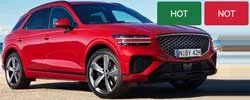Duckman7
Registered Member
- Joined
- May 18, 2023
- Messages
- 140
- Reaction score
- 58
- Points
- 28
- Genesis Model Year
- 2023
- Genesis Model Type
- Genesis GV80
Sebang Global Battery is the OEM for Genesis AGM batteries.
They posted a Youtube video explaining how to replace and properly maintain AGM batteries in vehicles with ISG system.
This video is in Korean, so I will briefly explain what they are saying in this video.
1) Smart generator control system
When the battery's SOC (state of charge) reaches 84% (~12.65V), the car stops charging and let the battery discharge to 12.5V (~70%).
Then the cycle repeats.
(Nominal alternator charging voltage is 14.3V, this should not be confused with resting voltage that SOC refers to.)
The battery is not charged when accelerating to save on gas and also not to burden the engine, and charged when decelerating.
2) ISG (Idling Stop and Go) system has integrated regenerative braking system.
ISG system is designed to save gas when you briefly stop at a light by stopping the engine and restart when you put your foot off the brake.
This obviously takes some juice from the battery each and every time.
To help with this, the ISG system integrates regenerative braking system.
Regenerative braking is a common feature for a hybrid or all-electric system, but I'm surprised to find out all-gasoline vehicles with ISG also have a version of regenerative braking system albeit probably much smaller in capacity.
Nevertheless, this gives me some peace of mind when using ISG that every time I slow down, the AGM battery is receiving some boosted charge from the brakes (as opposed to relaying on alternator and gas only) and use that harvested energy to help start the engine the next time.
3) They recommend their AGM batteries to be maintained with minimum of 12.60V (~76%).
What this tells me is that after driving the vehicle for a while, we should see battery level anywhere between 70% to 84%, provided you drove long enough to allow for sufficient time to charge/discharge.
Then the question is, why max 84% only and not 100%.
All other sources I've managed to find on the internet says the lead-acid batteries are best kept at full charge.
If left at a lower level for a long time, the sulfation crystals harden and the battery can no longer be charged beyond that level.
I suspect the reason the car is only designed to charge up to 84% is because that's the max level the bulk charging process can achieve.
To receive the remaining 16%, the battery must be kept in absorption charge phase and that takes relatively long time to receive the remaining 16%.
During the absorption charge phase, if there is a stop and go event, the amount of charge the battery lost cannot be recovered quickly because the battery cannot be charged quickly with high current like in the bulk charge phase.
Although this manufacturer does not say in the video (for obvious reasons), I think it is still a good idea to charge the battery to 100% using an external charger like once a month or as often as you can if you intend to keep the battery for a long time like 6+ years according to several owners who did just that.
They posted a Youtube video explaining how to replace and properly maintain AGM batteries in vehicles with ISG system.
This video is in Korean, so I will briefly explain what they are saying in this video.
1) Smart generator control system
When the battery's SOC (state of charge) reaches 84% (~12.65V), the car stops charging and let the battery discharge to 12.5V (~70%).
Then the cycle repeats.
(Nominal alternator charging voltage is 14.3V, this should not be confused with resting voltage that SOC refers to.)
The battery is not charged when accelerating to save on gas and also not to burden the engine, and charged when decelerating.
2) ISG (Idling Stop and Go) system has integrated regenerative braking system.
ISG system is designed to save gas when you briefly stop at a light by stopping the engine and restart when you put your foot off the brake.
This obviously takes some juice from the battery each and every time.
To help with this, the ISG system integrates regenerative braking system.
Regenerative braking is a common feature for a hybrid or all-electric system, but I'm surprised to find out all-gasoline vehicles with ISG also have a version of regenerative braking system albeit probably much smaller in capacity.
Nevertheless, this gives me some peace of mind when using ISG that every time I slow down, the AGM battery is receiving some boosted charge from the brakes (as opposed to relaying on alternator and gas only) and use that harvested energy to help start the engine the next time.
3) They recommend their AGM batteries to be maintained with minimum of 12.60V (~76%).
What this tells me is that after driving the vehicle for a while, we should see battery level anywhere between 70% to 84%, provided you drove long enough to allow for sufficient time to charge/discharge.
Then the question is, why max 84% only and not 100%.
All other sources I've managed to find on the internet says the lead-acid batteries are best kept at full charge.
If left at a lower level for a long time, the sulfation crystals harden and the battery can no longer be charged beyond that level.
I suspect the reason the car is only designed to charge up to 84% is because that's the max level the bulk charging process can achieve.
To receive the remaining 16%, the battery must be kept in absorption charge phase and that takes relatively long time to receive the remaining 16%.
During the absorption charge phase, if there is a stop and go event, the amount of charge the battery lost cannot be recovered quickly because the battery cannot be charged quickly with high current like in the bulk charge phase.
Although this manufacturer does not say in the video (for obvious reasons), I think it is still a good idea to charge the battery to 100% using an external charger like once a month or as often as you can if you intend to keep the battery for a long time like 6+ years according to several owners who did just that.
Last edited:









